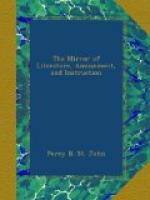“Maister Michael Scott’s man
Sought meat, and gat nane.”
[8] Merlini Coccaii Macaronica, xviii, p. 273.
Immediately the good old woman, instead of pursuing her domestic occupation, which was baking bread for the reapers, began to dance round the fire, repeating the rhyme, and continued this exercise, till her husband sent the reapers to the house, one after another, to see what had delayed their provision, but the charm caught each as they entered, and, losing all idea of returning, they joined in the dance and the chorus. At length the old man himself went to the house, but as his wife’s frolic with Mr. Michael, whom he had seen on the hill, made him a little cautious, he contented himself with looking in at the window, and saw the reapers at their involuntary exercise, dragging his wife, now completely exhausted, sometimes round, and sometimes through the fire, which was, as usual, in the midst of the house. Instead of entering, he saddled a horse, and rode up the hill, to humble himself before Michael, and beg a cessation of the spell, which the good-natured warlock immediately granted, directing him to enter the house backwards, and with his left hand take the spell from above the door, which accordingly ended the supernatural dance. * * * Michael Scott,” continues the same author, “once upon a time was much embarrassed by a spirit, for whom he was under the necessity of finding constant employment. He commanded him to build a cauld, or dam-head, across the Tweed at Kelso; it was accomplished in one night, and still does honour to the infernal architect. Michael next ordered that Eildon Hill, which was then a uniform cone, should be divided into three. Another night was sufficient to part its summit into the three picturesque peaks which it now bears. At length the enchanter conquered this indefatigable demon, by employing him in the hopeless and endless task of making ropes out of the sea-sand."[9]
[9] Notes to the lay of the Last Minstrel, p. 255.
The embellishments, six in number, are engraved in a pleasing style by W.H. Lizars. Two of them,—a Norwegian Barrow, and Turnberry Castle, are very effective.
* * * * *
THE GATHERER.
A snapper up of unconsidered trifles.
SHAKSPEARE.
* * * * *
An Irish knight was married to the daughter of a noble lord, a connexion of which the knight was somewhat proud. Boasting of this union once to a friend, he observed that his lordship had paid him the highest compliment in his power. “He had seven daughters,” said he, “and he gave me the ouldest, and he told me, too, that if he had an oulder I should have her.”
* * * * *
A SHIRT WITHOUT A SEAM.
At Dumferline, in the corporation chest is preserved a man’s shirt, wrought in the loom about a century ago, by a weaver of the name of Inglis. The shirt was formed without a seam, and finished without any assistance from the needle; the only necessary parts he could not accomplish were the neck and sleeve buttons.




